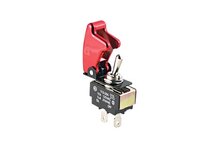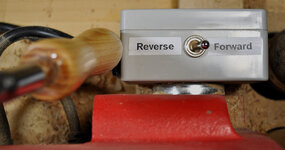Bob at RJBWoodturning has a
video on modifying a midi lathe (the PSI Turncrafter) to add a reversing switch. Since I have the same lathe, I found it very helpful in doing the hack on my lathe.
The major issues that have to be addressed are:
1. Finding a suitable DPDT switch. As others have noted, you NEVER want to change the direction of the lathe instantaneously, so using a switch that has a 'center off' feature provides an extra margin of protection. I found my switch at Home Despot. Incidentally, there is also the matter of how the switch has to be wired. I opted for a switch that had screw connections, but you can also find switches with soldered connections, or switches with lugs that use special 'Stakon' wire connectors.
2. Mounting the switch. I've seen a video in which the switch was mounted in the controller box, but I was concerned that there isn't a lot of 'wall space' to work with. So I located a small plastic box on e-Bay that I used to house the switch. The box I bought was actually manufactured to mounting/connecting exterior video cameras and came with a weather seal where the top attached to the bottom. I mounted a 2" round magnet (from Harbor Freight) on the back of the box so that it could be stuck anywhere on the lathe base.
3. Bob identified that the motor cable on the Turncrafter lathe plugs into the controller using a standard IEC connector set (the same connector set used to plug the power cord into a computer). You can purchase extension cords with male and female connectors from Amazon - I opted for an 18" cord thinking that would be long enough - it works, but in retrospect, I should have used a longer cable so that I have more flexibility in where I stick the switch box on my lathe. With the shorter cable, I have to stick it to the foot of the lathe at the tailstock end - that's fine because it's hidden, and I have to really want to reverse the lathe before I reach around to flip the switch. But the downside is that the tailstock locking handle sometimes bumps into the switch handle. Just a minor inconvenience rather than a show stopper.
The point about screw-on chucks is a valid concern. However, for sanding, that's usually not a problem since you normally want to run the lathe fairly slowly.


